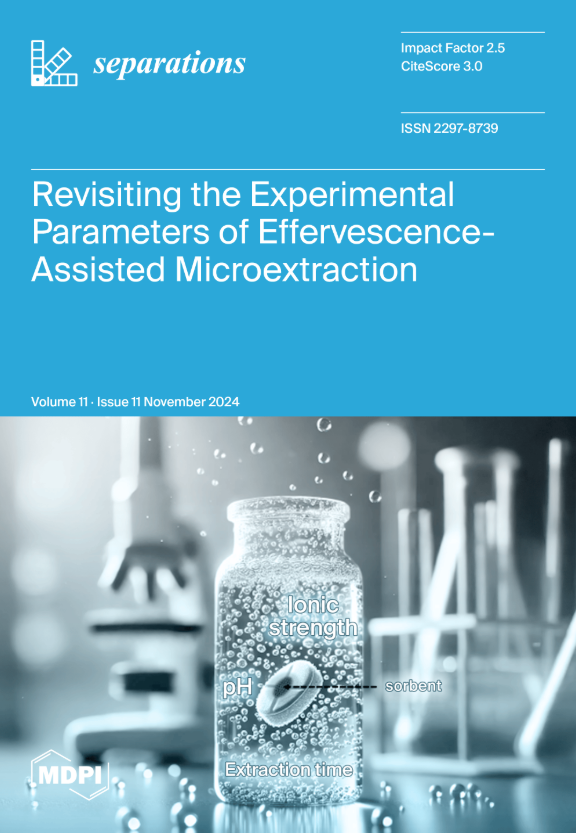氯化胆碱对聚合物/聚合物双水相体系相平衡及配分性能的影响
IF 2.7
4区 工程技术
Q3 CHEMISTRY, ANALYTICAL
引用次数: 0
摘要
以聚乙二醇(PEG)和聚丙烯酸钠(NaPA)为原料,氯化胆碱([Ch]Cl)为佐剂,测定了一系列聚合物双水相体系(ABS)。考察了(i) PEG和NaPA分子量、(ii) PEG功能化、(iii) [Ch]Cl添加量(不同浓度)和(iv)温度(25、37和50℃)对两相分离的促进作用。结果表明,聚乙二醇聚合物的聚合度和功能化对ABS的形成有较大影响,高分子量的聚乙二醇诱导双相区增加。此外,加入少量(1-5 wt%)的[Ch]Cl也提高了液液脱混效果。温度和NaPA分子量的增加对ABS形成能力没有影响。最后,以咖啡因为模型化合物,评价PEG/NaPA + [Ch]Cl ABS的分割性能。与ABS的形成趋势不同,NaPAs的分子量显著影响了ABS的分配,使用NaPA-8000后,这种分配得到了加强。此外,[Ch]Cl的加入促进了咖啡因的分配行为的反转,从而强调了这些系统所表现出的显著的分配裁剪潜力。总的来说,所有系统似乎都是有效提取、纯化和/或浓缩不同增值生物分子的有希望的替代方案。本文章由计算机程序翻译,如有差异,请以英文原文为准。
Influence of Choline Chloride on the Phase Equilibria and Partition Performance of Polymer/Polymer Aqueous Biphasic Systems
A series of polymeric aqueous biphasic systems (ABS) were determined using polyethylene glycol (PEG) and sodium polyacrylate (NaPA) with choline chloride ([Ch]Cl) as an adjuvant. The effect of (i) PEG and NaPA molecular weights, (ii) PEG functionalization, (iii) [Ch]Cl addition (at different concentrations), and (iv) temperature (25, 37 and 50 °C) was evaluated through their ability to promote the two-phase separation. The results showed that the polymerization degree and functionalization of PEG polymers exhibit a large influence on the ABS formation, with high molecular weight PEG inducing an increase in the biphasic region. Furthermore, the addition of small amount (1–5 wt%) of [Ch]Cl also increased the liquid–liquid demixing. Temperature and the increase in the NaPA molecular weight did not influence the ABS formation ability. Finally, the partition performance of PEG/NaPA + [Ch]Cl ABS was evaluated using caffeine as a model compound. Unlike the ABS formation trend, NaPAs molecular weight significantly influenced the partitioning, which was strengthened when using NaPA-8000. Moreover, the incorporation of [Ch]Cl facilitated an inversion in the partitioning behavior of caffeine, thereby emphasizing the remarkable partitioning tailoring potential exhibited by these systems. Overall, all systems seem to be promising alternatives for the effective extraction, purification and/or concentration of different value-added biomolecules.
求助全文
通过发布文献求助,成功后即可免费获取论文全文。
去求助
来源期刊

Separations
Chemistry-Analytical Chemistry
CiteScore
3.00
自引率
15.40%
发文量
342
审稿时长
12 weeks
期刊介绍:
Separations (formerly Chromatography, ISSN 2227-9075, CODEN: CHROBV) provides an advanced forum for separation and purification science and technology in all areas of chemical, biological and physical science. It publishes reviews, regular research papers and communications. Our aim is to encourage scientists to publish their experimental and theoretical results in as much detail as possible. There is no restriction on the length of the papers. The full experimental details must be provided so that the results can be reproduced. There are, in addition, unique features of this journal:
Manuscripts regarding research proposals and research ideas will be particularly welcomed.
Electronic files and software regarding the full details of the calculation and experimental procedure, if unable to be published in a normal way, can be deposited as supplementary material.
Manuscripts concerning summaries and surveys on research cooperation and projects (that are funded by national governments) to give information for a broad field of users.
The scope of the journal includes but is not limited to:
Theory and methodology (theory of separation methods, sample preparation, instrumental and column developments, new separation methodologies, etc.)
Equipment and techniques, novel hyphenated analytical solutions (significantly extended by their combination with spectroscopic methods and in particular, mass spectrometry)
Novel analysis approaches and applications to solve analytical challenges which utilize chromatographic separations as a key step in the overall solution
Computational modelling of separations for the purpose of fundamental understanding and/or chromatographic optimization
 求助内容:
求助内容: 应助结果提醒方式:
应助结果提醒方式:


